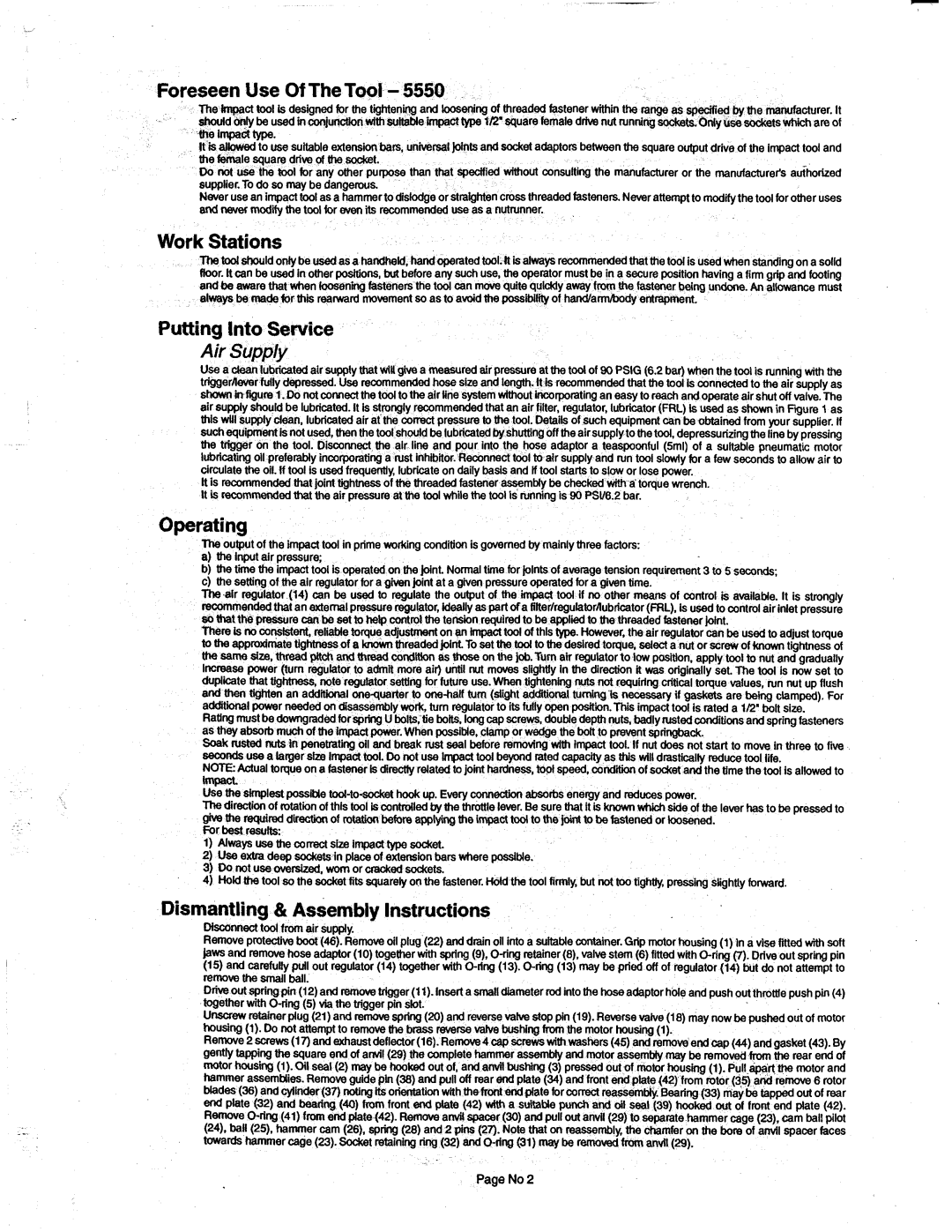
Foreseen Use Of TheTool -5550
The Impacttool is designedfor the tightening and looseningof threaded fastener within the range as specified by the manufacturer. It shouldonly be usedinconjunctionwith suitableimpacttype 112" squarefemale drive nut runningsockets. Only usesocketswhich are of Die Impacttype.
It isallowedto use suitable extensionbars, universaljoints and socket adaptors betweenthesquareoutput drive of the impacttool and the female square drive of thesocket.
Do not use the tool for any other purpose than that specified without consulting the manufactureror the manufacturer'sauthorized supplier. To do so may bedangerous.
Never useanimpacttool as a hammerto dislodgeor straightencrossthreadedfasteners. Neverattemptto modifythe tool for other uses andnever modify the tool for even its recommendeduse as a nutrunner.
Work Stations
Thetoolshouldonlybeusedasa handheld, handoperatedtoot.# Isalways~~~OInmendedthatthe tool is usedwhen standingona solid floor. It can be usedinother positions, but before any such use, the operator must be in a secure positionhavinga firm grip and footing andbe aware that when looseningfastenersthe tool can move quite quicklyaway from the fastener being undone. An allowance must alwaysbe madefor this rearwardmovement so as to avoidthe possibilityof handlarmhmdyentrapment.
Putting Into Service
Air Supply
Usea cleanlubricatedair supply that willgivea measuredair pressure at thetoolof 90 PSIQ (6.2 bar) when the tool is runningwith the triggerheverfully depressed. Userecommendedhosesize and length. Itis recommendedthat the tool is connectedto the air suoolv as shownInfigure 1. Do notconnect the toolto the air line systemwithout incorporatinganeasy to reachandoperateair shut off vake.The air supply should be lubricated.It Isstrongly recommendedthat an air filter, regulator, lubricator(FRL) is used as shown in Figure 1 as thls will supply dean, lubricatedair at the correct pressureto the tool. Detailsof such equipment can beobtainedfrom your supplier. If suchequipmentisnot used, thenthe tool shouldbelubricatedbyshuttingoffthe air supplyto the tool, depressurizingthe linebypressing the trigger on the tool. Disconnect the air line and pour into the hose adaptor a teaspoonful (5ml) of a suitable pneumatic motor lubricatingoil preferablyincorporatinga rust inhibitor. Reconnecttool to air supply and run tool slowly for a few seconds to allow air to circulatethe oil. tf tool Isusedfrequently,lubricateon daily basis and If tool starts to slow or lose power.
It is recommendedthatjoint tightnessof the threaded fastener assembly be checked with a toque wench.
It is recommendedthat the air pressureat the toolwhile the tool is runningis 90 PSI/6.2 bar.
Operating
The output of the impacttool in prime workingcondition is governedby mainly three factors:
a)the Inputair pressure;
b)the time the impacttool is operatedon thejoint. Normaltime for joints of average tension requirement3 to 5 seconds;
c)the settingof the air regulatorfor agivenjoint at a given pressureoperatedfor a given time.
The air regulator (14) can be used to regulate the output of the impact tool if no other means of control is available. It is strongly recommendedthat anexternalpressureregulator. Ideallyas partofa filterlregulator~lubricator(FRL), isusedto controlair inletpressure so that the pressure canbe set to help controlthetension requiredto beapplied to the threaded fastenerjoint.
There is no consistent, reliabletoque adjustmenton an Impacttool of thls type.However, the air regulator can be usedto adjust toque to the approximatetightnessof a knownthreadedjoint To set the tool to thedesiredtoque, select a nut or screw of knowntightnessof the same size, thread pitch andthread condition as thoseon the job. Turn air regulatorto low position, apply tool to nut and gradually increase power (turn regulator to admit more aio until nut moves slightly In the direction it was originally set. The tool is now set to duplicatethat tightness, note regulator setting for future use. When tightening nutsnot requiring criticaltoque values, run nut up flush and then tighten an additionalonequarter to
Ratingmustbedowngradedfor springUbolts, tie bolts, longcap screws,doubledepthnuts, badlyrustedconditionsandspringfasteners as they absoib muchof the impactpower. When possible, clampor wedge the bolt to preventspringback.
Soak rusted nuts in penetratingoil and break rust seal before removingwith impact tool. If nut does not start to move in three to five Secondsuse a largersize Impacttool. Do not use Impact tool beyond ratedcapacity as this will drasticallyreducetool life.
NOTE:Actual toque on a fastenerIsdirectlyrelatedtojoint hardness, too)speed, conditionof socket and the time the tool is allowed to impact.
Usethesimplestpossible
Thedirectionof rotationof this tool is controlled bythethrottlelever. Besure that it is knownwhich sideof the lever has to be pressedto give the requireddirectionof rotationbeforeapplyingthe impacttoolto the joint to befastened or loosened.
Forbest results:
1)Always use the correct size impact type socket.
2)Use extra deep socketsin placeof extensionbars where possible.
3)Do not useoversized, wornor cracked sockets.
4)Hold thetool so the socket fits squarelyon the fastener. Holdthetool firmly, but not too tightly, pressingslightly forward.
Dismantling& Assembly Instructions
DiSC~nnecttool from air supply.
Removeprotectiveboot (46). Removeoil plug(22) anddrain oil into a suitablecontainer. Grip motor housing(1) in a vise fitted with soft jaws and removehoseadaptor (10) together with spring (9),
(15)and carefully pull out regulator (14) together with
Driveoutspringpin(12) and removetrigger (11). Inserta smalldiameter rodintothe hoseadaptorholeand pushoutthrottle pushpin(4) together with
Unscrewretainerplug (21) and removespring(20) and reversevalve stop pin(19). Reversevalve (18) may nowbepushedoutof motor housing (1). Do not attemptto remove the brass reversevalve bushingfromthe motor housing(1).
Remove2 screws(17)andexhaustdeflector(16). Remove4 capscrewswithwashers (45) and removeendcap (44) andgasket(43). By gently tappingthesquare end of anvil (29) the complete hammer assembly and motorassembly may be removedfromthe rear end of motor housing(1).Oil seal (2) may be hookedout of, and anvil bushing (3) pressedout of motor housing (1). Pullapart the motor and hammerassemblies. Removeguidepin (38) andpulloff rear end plate (34) and front endplate(42) from rotor (35) and remove 6 rotor blades(36)andcylinder(37) notingitsorientationwith thefront endplateforcorrectreassembly. Bearing(33) maybetappedout of rear end plate (32) and bearing(40) from front end plate (42) with a suitable punch and oil seal (39) hooked out of front end plate (42).
(24). ball (251, hammer cam (26). spm (28) and 2 pins (27). Notethat on reassembly,the chamfer on the bore of anvil spacer faces towards hammer cage (23). Socket retaining ring(32)
Page No 2
